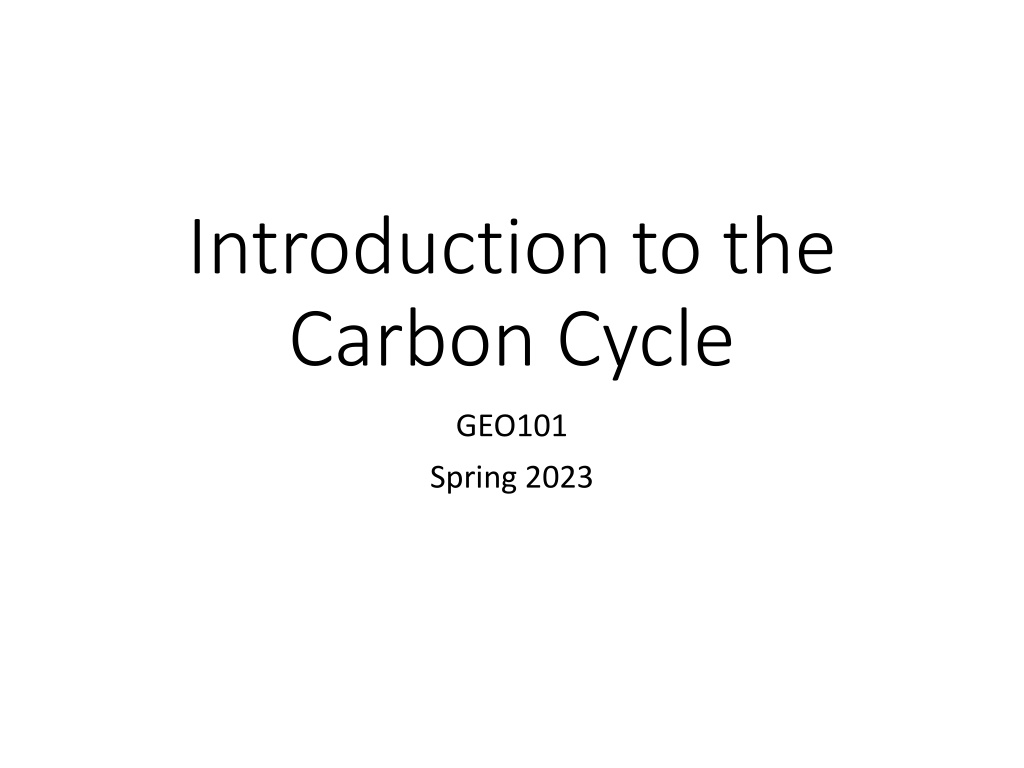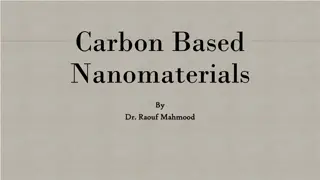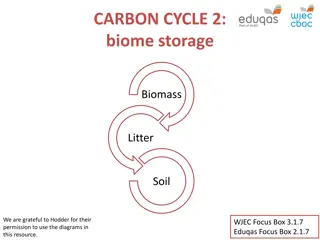Understanding the Carbon Cycle: Reservoirs, Dynamics, and Importance
Earth's carbon cycle plays a crucial role in sustaining life, with carbon moving through various reservoirs and processes. This cycle involves short-term terrestrial and marine cycles, as well as long-term cycles influenced by volcanic activity and rock weathering. Understanding carbon reservoir dynamics helps us realize how carbon flows through different components such as living organisms, atmosphere, sediments, fossil fuels, and ocean water. The balance between carbon inflows and outflows in these reservoirs is essential for maintaining a stable environment.
Download Presentation

Please find below an Image/Link to download the presentation.
The content on the website is provided AS IS for your information and personal use only. It may not be sold, licensed, or shared on other websites without obtaining consent from the author. Download presentation by click this link. If you encounter any issues during the download, it is possible that the publisher has removed the file from their server.
E N D
Presentation Transcript
Introduction to the Carbon Cycle GEO101 Spring 2023
Contents A Brief Overview Carbon Reservoirs and their Dynamics Types of Carbon Organic Carbon Cycling Short-Term Terrestrial Organic Carbon Cycle Short-Term Marine Organic Carbon Cycle
A brief overview Earth is only planet w/ life. just-right distance from sun Water is essential. Venus: H2O vapor = no life = no C cycle Mars: ice Mercury: small, atmosphere no GHG Temperature: Venus > Mercury > Earth > Mars
A brief overview Earth is only planet w/ life. Recycling of essential nutrients occurs on Earth. Recycling is the movements of water, life, soil, atmosphere, etc. Without these processes, nutrients get locked up
Carbon cycle Carbon is one of the most important nutrients for life. part of living organism and it is greenhouse gas. Three carbon-cycles: short-term terrestrial: photosynthesis and respiration short-term marine: phytoplankton long-term cycles: through volcanic activity, rock weathering, and burial of sediments
Carbon Reservoir Dynamics Where is the carbon? Carbon reservoirs are components that hold carbon. rock, ocean water, fossil fuels, sediments, atmosphere, and living organism.
Living organisms Atmosphere Sediments Fossil fuels Ocean water rock
Carbon Reservoir Dynamics Reservoirs only temporarily hold carbon. For example, burning forests release carbon into atmosphere. Even rocks are losing carbon into the atmosphere.
Carbon Reservoir Dynamics Reservoirs have inflows and outflows. - atmosphere - forests have the opposite - bank account analogy
Carbon Reservoir Dynamics equilibrium: inflow = outflow Annually, atmosphere carbon is approximately in equilibrium. Globally, atmospheric carbon is highest in May and lowest in September.
Carbon Reservoir Dynamics Relation between CO2 and photosynthesis: As CO2 increases, photosynthetic rate increases. As photosynthetic rate increases, CO2 decreases. This negative coupling slows down the change of CO2 in the atmosphere.
Types of carbon chemical definitions: organic C molecules: C w/ C or H inorganic C molecules: C w/o problem: organisms create both Earth-systems definitions: organic: stored/moved by biotic processes. inorganic: abiotic processes CO2 could thus be either organic or inorganic.
Types of carbon oxidized vs. reduced: Oxidized C is bonded to O, such as CO2. Reduced C is not bonded to oxygen, such as CH4. Oxygen is highly reactive; thus, reduced carbon is easily converted to the oxidized form. Evolution of life changed atmosphere, more O2, resulting more oxidized elements.
Organic Carbon Cycling photosynthesis involves reduction of CO2: CO2 + H2O + sun energy CH2O (carbohydrate) + O2 Plants/algae have pigments or chlorophyll that allows them to photosynthesize. 6CO2 + 6H2O + sun energy C6H12O6 (glucose) + 6O2
Organic Carbon Cycling Respiration involves oxidation: CH2O + O2 CO2 + H2O + chemical energy C6H12O6 + 6O2 6CO2 + 6H2O + chemical energy Plants respire all the time Animals & bacteria also respire.
Organic Carbon Cycling methanogenesis: anaerobic decomposition 2CH2O CO2 + CH4 + chemical energy C6H12O6 3CO2 + 3CH4 + chemical energy Occurs when organic matter is wet and little oxygen.
Short-term Terrestrial Organic Carbon Cycle terrestrial carbon reservoirs: 2.5x more C in soil sediments than in living organisms. Soils have two types of dead organic carbon: litter dead materials humus tiny clay particles coats the mineral matter in the topsoil and make it dark Reservoir residence time vary from years to centuries. Carbon in living organisms change more rapidly. A Year in the Life of Earth s CO2
Litter humus
Photosynthesis Gross Photosynthesis total amount of carbohydrate produced Net Photosynthesis amount of carbohydrate remaining after respiration
Net Primary Productivity NPP = photosynthesis respiration photosynthesis only during growing season respiration all year January spatial pattern: positive: S. Hem negative: N. Hem e.g., Buffalo NY NPP in July would be opposite.
Net Primary Production Accumulated net production by photosynthesis = biomass (dry weight of organic matter) Rainforest of equatorial zone 2000 grams/sq. metre per year
Net Primary Production Freshwater swamps and marshes 2500 Mid-latitude forest 1300 Mid-latitude grassland 500
Net Primary Production Deserts 3 Algal beds and reefs 2000 Open oceans 125
Net Production and Precipitation Net production increases rapidly with increasing precipitation, but level off at higher values.
Biomass as an Energy Source Burning of wood, vegetation and other organic materials such as crop residues Or generate fuels methane gas, charcoal and alcohol Useful to reduce emissions of carbon dioxide from the burning of fossil fuels
Short-term Marine Organic Carbon Cycle Phytoplankton: (shown many hundred times their actual size) Coccolithophores Diatom Diatom and coccoliths Dinoflagellate
Short-term Marine Organic Carbon Cycle 70% of Earth covered by ocean. producers: organisms producing food through photosynthesis Phytoplankton are marine producers. (most are algae)
Diatom: SiO2 (silicon dioxide) shell coccolithophorids: CaCO3 (calcium carbonate) shell Coccolithophores Diatom
Short-term Marine Organic Carbon Cycle Phytoplankton photosynthesize, so consume CO2, and produce O2 and carbohydrates. top 100 meters
Short-term Marine Organic Carbon Cycle foraminifera Consumers are organisms feeding on producers. Most are zooplankton free-floating, CaCO3/SiO2 shell Other organisms swim; size range from tiny krill to whales total biomass < plankton krill
Biological pump Photosynthesis of phytoplankton reduces CO2 at surface. Zooplankton consume phytoplankton. Waste from zooplankton and dead plankton sink. Decomposers eat the waste (99.9%). 0.1% of C is not decomposed and buried in ocean sediment. Net decrease in CO2 in the ocean water makes atmospheric CO2 easier to dissolve into the water. Summarize: more plankton = more waste = more C in sediment = more CO2 taken out of atmosphere
Annual change in sunlight and productivity Oceanic midlatitude
Spatial patterns Satellites detect pigments of phytoplankton. July pattern: only high in high northern latitudes. On the other hand, terrestrial productivity is high in many latitudes, where it is warm and moist.
Marine pattern differs from the terrestrial one because: One of the limitation for plankton growth is nutrient. Water layer mixing and upwelling of nutrients help plankton. In high latitudes, dense water sink, mixing the layers. In other latitudes, mixing is prevented.























